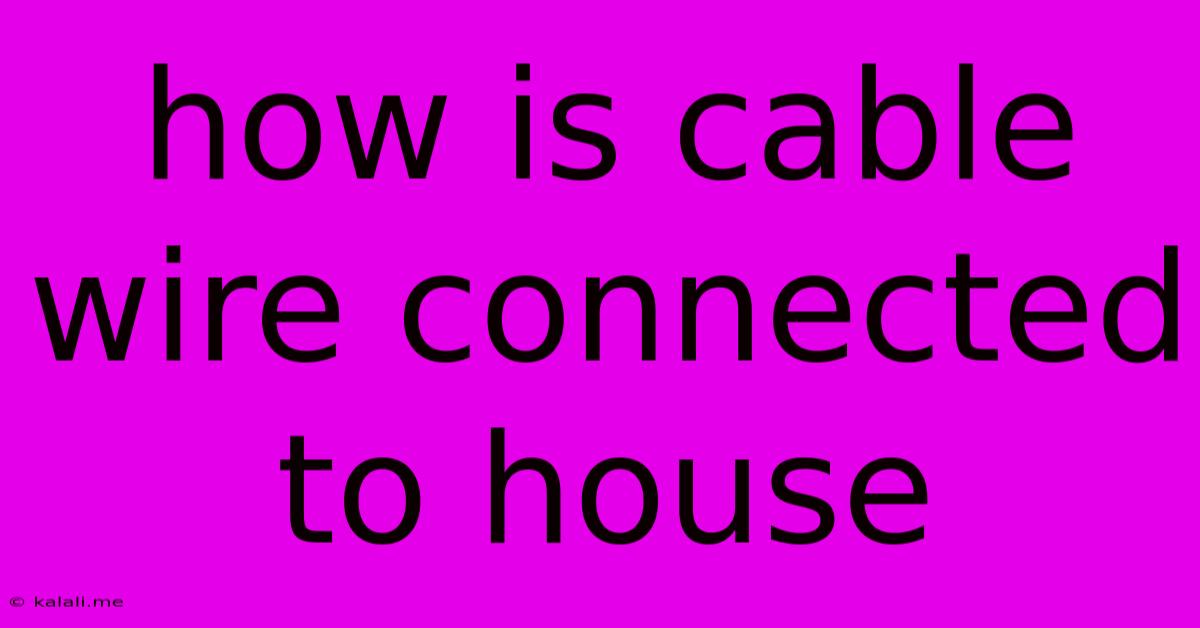How Is Cable Wire Connected To House
Kalali
Jun 03, 2025 · 3 min read

Table of Contents
How is Cable Wire Connected to Your House? A Comprehensive Guide
Meta Description: Learn how cable TV and internet connections are established in your home, from the main cable line to the wall outlets. This guide covers the process step-by-step, including safety precautions and common connection types.
Getting cable TV or internet service installed in your home might seem like a simple process, but understanding the underlying connections can be helpful for troubleshooting or future upgrades. This guide details the journey of your cable wire, from the main cable line to the various outlets inside your house. We'll explore the different types of connections, safety measures, and common issues you might encounter.
From the Street to Your Home: The Main Connection
The process begins outside your home, where the main cable line from your service provider connects to your property. This usually involves a cable drop, a wire running from the main cable line on the street to a connection point on your house, often a junction box or a wall-mounted connection. This connection point is crucial because it’s where the signal enters your home. The cable is often secured to your house using weatherproof clamps and straps. Sometimes this initial connection involves burying the cable underground for aesthetic reasons or to protect against damage.
Inside the Walls: The Cable's Journey
Once inside, the cable usually travels through the walls, often within conduit for protection and organization. The route is planned to minimize disruption and ensure signal strength. This internal cabling may use various methods, depending on the age and construction of your home. Older homes might have exposed cabling, while newer homes often have it concealed within the walls.
The Distribution Point: The Cable Box or Splitter
Inside your home, the single cable line is typically connected to a cable box or splitter. The cable box acts as a central distribution point, distributing the signal to different rooms or outlets. A splitter divides the signal, sending it to multiple outlets – this is essential if you have multiple TVs or internet devices in your home requiring a cable connection.
Connecting to Your Devices: Coaxial Connectors
The final connection is from the wall outlets to your devices using coaxial cables and F-type connectors. These are the familiar screw-on connectors that ensure a secure and reliable connection. Properly screwing on these connectors is crucial to prevent signal loss. Loose or damaged connectors are a frequent cause of poor cable reception.
Types of Cable Connections:
- Coaxial Cable: The most common type, carrying both video and internet data.
- Fiber Optic Cable: Increasingly popular for high-speed internet, offering superior bandwidth and signal quality. Fiber optic connections usually end at a conversion point near the cable box, which then uses coaxial cable internally.
Safety Precautions:
- Always turn off the power: Before working with any electrical or cable connections, always switch off the power to the associated circuits.
- Use appropriate tools: Employ the correct tools for the job to avoid damaging the cables or connectors.
- Don't work alone: If you're unsure about any aspect of the connection process, seek professional assistance.
- Beware of live wires: Always be mindful of potentially exposed live wires.
Troubleshooting Common Issues:
- Weak or No Signal: Check all connectors for tightness, look for damaged cables, and consider calling your cable provider.
- Intermittent Service: Investigate potential weather-related damage to external cabling.
- Signal Splitting Issues: Ensure your splitter is appropriately rated for the number of outlets.
Understanding how cable is connected to your home is not only useful for troubleshooting but also for planning future upgrades or home improvements. By familiarizing yourself with the process, you can better manage your cable services and maintain optimal performance. Remember to always prioritize safety and seek professional help if you're not comfortable working with electrical connections.
Latest Posts
Latest Posts
-
Multiplicity Matlab Solve Only Giving Solution Once
Jun 04, 2025
-
How To Remove Blood From Rug
Jun 04, 2025
-
Show Me Please I Totally Dont Mind Helping You
Jun 04, 2025
-
How Do You Cut Wood At An Angle
Jun 04, 2025
-
Can Healing Fix Broken Bones Dnd
Jun 04, 2025
Related Post
Thank you for visiting our website which covers about How Is Cable Wire Connected To House . We hope the information provided has been useful to you. Feel free to contact us if you have any questions or need further assistance. See you next time and don't miss to bookmark.